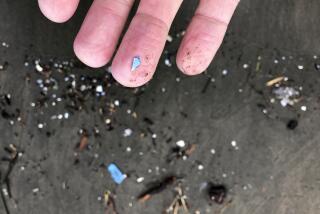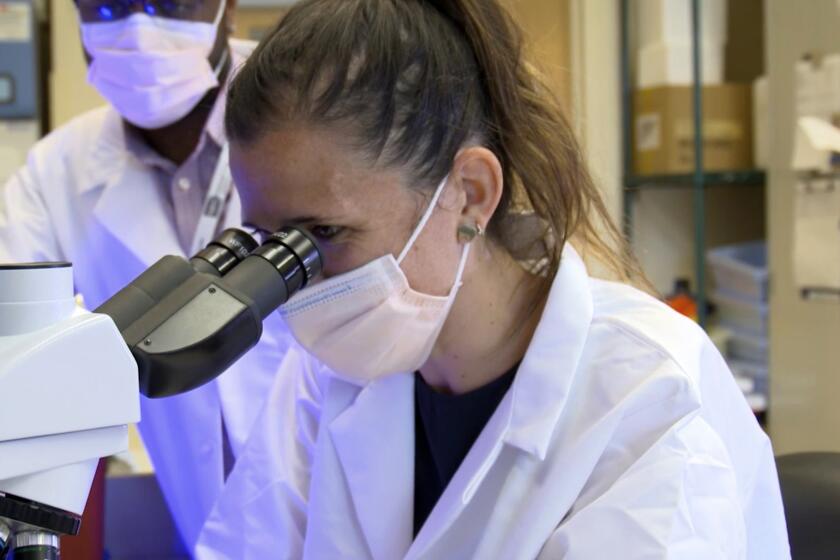Tobacco Smoke Harms Arteries, Study Finds
- Share via
Both smoking and passive exposure to tobacco smoke can accelerate irreversible hardening of the arteries, according to the largest study ever to examine tobacco’s effects on atherosclerosis.
The finding is surprising because scientists had not known that, unlike cigarette-induced lung damage, the cardiovascular damage in many cases is irreversible. Nor had they previously had hard evidence that secondhand smoke could cause this type of artery damage, the researchers said.
Smoking is one of the most important risk factors contributing to atherosclerosis, which causes heart attacks and strokes, according to a report in today’s Journal of the American Medical Assn.
The new findings, according to the American Heart Assn., provide strong evidence to support bans on smoking in bars and other public places.
A team headed by epidemiologist George Howard of Wake Forest University studied 10,914 people enrolled in a study of all risk factors for atherosclerosis.
They found that smokers had a 50% increase in the rate of plaque accumulation in the carotid arteries, ex-smokers had a 25% increase, and people passively exposed to smoke a 20% increase. The risk was greater for people with diabetes or hypertension.
“This is pretty striking evidence,” said Dr. Sidney Smith of the University of North Carolina at Chapel Hill. “We knew that populations who smoked had an increase in heart disease. Now we know why.”
“This is a good study . . . that went right to the heart of the matter,” said Dr. Aubrey Taylor of the University of South Alabama College of Medicine in Mobile. “It will be very difficult for the tobacco companies to argue it away,” added Taylor, who has prepared the American Heart Assn.’s position papers on secondhand smoke.
But Tom Lauria, a spokesman for the tobacco industry’s Tobacco Institute, argued that earlier studies “do not show any increased risk for nonsmokers. We consider the science to be inconclusive.”
The nearly 11,000 people in the Atherosclerosis Risk in Communities study were drawn from Minnesota, Maryland, Mississippi and North Carolina. All were between the ages 45 and 64 when they entered the study.
At the beginning of the study, researchers used ultrasound to measure the thickness of the walls of the carotid arteries, which supply blood to the brain. Three years later, the thickness was measured again.
As the walls thicken, they narrow the interior of the arteries, reducing blood flow like rust on the inside of pipes restricts water flow. The buildup of plaque also makes it more likely that a clot will form, totally blocking blood flow.
Hardening of the carotid arteries has previously been associated with an increased risk of stroke. Furthermore, Smith said, such hardening has been shown to be accompanied by hardening of the coronary arteries, which supply blood to the heart.
When the team compared measurements at the beginning and end of the study, they found that the carotid artery walls of smokers had grown 50% more than those of nonsmokers. Those of people who had quit smoking before the study began grew 25% more than those of nonsmokers.
But researchers found that the rate of thickening was less dependent on whether a person was smoking at the time of the study than on how much that person had smoked over the course of a lifetime, as measured in pack-years. (Two packs a day for one year, for example, equals two pack-years.)
Smokers and ex-smokers who had accumulated the same number of pack-years showed the same rates of thickening. This suggests, Howard said, that the smoke triggers an irreversible process that continues long after a smoker has kicked the habit.
“People can’t smoke for 30 years, then suddenly quit and expect that they will be as healthy as someone who has never smoked,” said John Banzhaf, executive director of the anti-smoking group Action on Smoking and Health.
The researchers also found, surprisingly, that nonsmokers exposed to significant amounts of secondhand smoke showed 20% more thickening than nonsmokers.
“It is shocking to me that nonsmokers exposed to secondhand smoke still face about a third of the risk of smokers,” Howard said.
And finally, they found that both smoking and passive exposure accelerates the damage to arteries associated with diabetes and hypertension. That “really indicates the seriousness of this risk,” Taylor said.
Action on Smoking and Health and the American Heart Assn. argued that the new study provides more evidence that, in order to protect the health of all nonsmokers, particularly children, smoking must be banned in all public places, including restaurants and bars.
“People in California have already done a pretty good job of that,” Taylor said. “Now we have to convince the rest of the country.”





